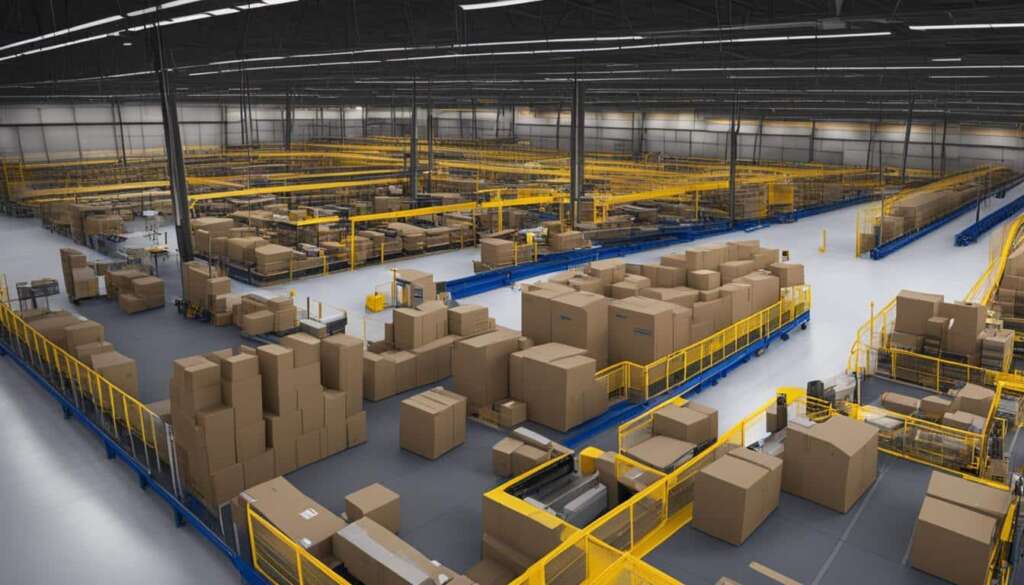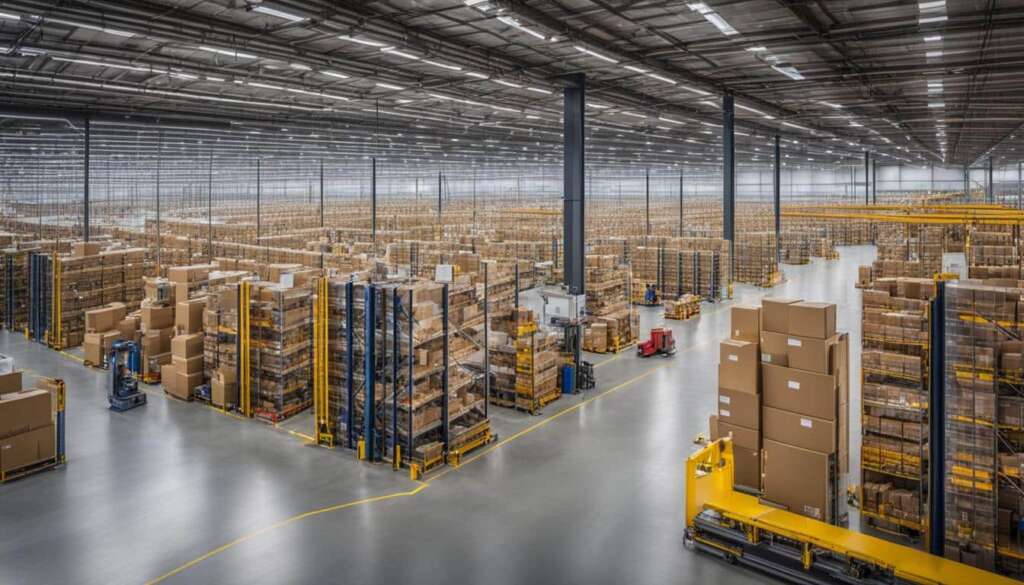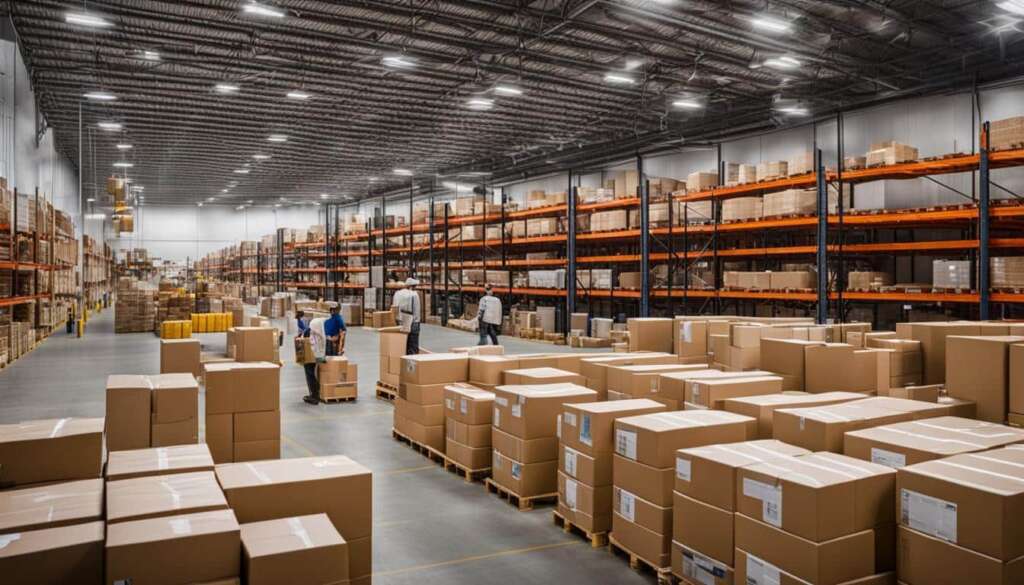Table of Contents
Ecommerce warehousing plays a vital role in the efficient management of online businesses. It encompasses the secure storage of products, inventory tracking, warehouse operations management, and compliance with safety regulations. As e-commerce businesses grow, they require more space and effective warehousing solutions to accommodate their increasing order volume. By investing in proper warehousing, businesses can experience faster shipping, improved product organization, reduced stress for business owners, and enhanced inventory management.
E-commerce warehousing is of utmost importance for the success of any online business. It enables businesses to meet customer expectations by facilitating quick and efficient product delivery. Additionally, it ensures proper organization of products, minimizing instances of lost items and simplifying inventory tracking. Moreover, e-commerce warehousing alleviates the burden and time-consuming tasks associated with inventory management, allowing business owners to focus on growing their ventures and potentially saving on time and costs.
The Importance of Ecommerce Warehousing
Ecommerce warehousing plays a crucial role in the success of an e-commerce business. It not only enables businesses to fulfill customer orders in a timely manner but also ensures better organization of products and improved inventory tracking.
One of the key benefits of ecommerce warehousing is the ability to ship products quickly and efficiently. With a dedicated warehouse for e-commerce, businesses can meet customer expectations for fast delivery, which is essential in today’s highly competitive online marketplace.
Effective warehouse management also helps to reduce the chances of lost items and improves inventory tracking accuracy. With a proper system in place, businesses can easily locate and retrieve products when needed, minimizing the risk of stockouts and ensuring a seamless order fulfillment process.
Furthermore, ecommerce warehousing relieves business owners of the stress and time-consuming tasks involved in managing inventory themselves. With a dedicated warehouse, they can focus on other core aspects of their business, such as marketing, customer service, and overall growth.
Moreover, ecommerce warehousing provides the potential for time and cost savings. By outsourcing warehousing operations to a specialized facility, businesses can benefit from economies of scale, efficient storage solutions, and streamlined processes. This allows them to optimize their resources and reduce operational costs.
In summary, ecommerce warehousing is not only essential for meeting customer demands but also for ensuring efficient inventory management and reducing the burden on business owners. By investing in dedicated warehousing solutions, businesses can enhance their competitiveness, improve customer satisfaction, and achieve long-term success.
“Ecommerce warehousing is the backbone of a successful online business, ensuring efficient order fulfillment and optimal inventory management.”
| Benefits of Ecommerce Warehousing |
|---|
| Fast and efficient product shipping |
| Improved organization and inventory tracking |
| Relieves business owners of inventory management tasks |
| Potential for time and cost savings |
Types of E-commerce Warehouses
When it comes to e-commerce warehousing, businesses have several options to choose from. Each type of warehouse offers unique advantages and caters to different needs. Understanding the types of e-commerce warehouses available can help businesses make informed decisions to optimize their operations and meet customer expectations.
Consolidated Warehouses
Consolidated warehouses provide a central location for multiple businesses to store their inventory. By sharing a warehouse space, businesses can benefit from cost efficiencies and streamlined operations. This type of warehouse is particularly beneficial for smaller businesses or those seeking to minimize warehousing costs. Consolidated warehouses offer shared resources and logistics support, allowing businesses to focus on their core activities while enjoying the advantages of a dedicated warehousing facility.
Fulfillment Centers
Fulfillment centers specialize in storing and quickly fulfilling orders for online merchants. These warehouses are designed to handle high volumes of orders efficiently, offering advanced order processing capabilities and same-day shipping options. Fulfillment centers often integrate with online marketplaces and e-commerce platforms, allowing seamless order fulfillment and inventory management. By leveraging the expertise and infrastructure of these specialized warehouses, businesses can enhance their operational efficiency and ensure timely delivery to their customers.
Public Warehouses
Public warehouses offer storage services and additional facilities like order fulfillment, shipping, and distribution. These warehouses cater to businesses that require flexibility in managing their inventory. Public warehouses may provide short-term or long-term storage solutions based on business needs. This type of warehouse offers cost-effective options for businesses that may experience fluctuating demand or seasonal peaks. By leveraging public warehouse services, businesses can save on infrastructure costs and scale their operations as required.
| Warehouse Type | Advantages |
|---|---|
| Consolidated Warehouses |
|
| Fulfillment Centers |
|
| Public Warehouses |
|
Choosing the right type of e-commerce warehouse depends on various factors such as business size, order volumes, and inventory management requirements. By understanding the benefits and capabilities of each type, businesses can make informed decisions that align with their specific needs and goals.
Managing an E-commerce Warehouse
Effectively managing an e-commerce warehouse involves several key components. An efficient inventory system is crucial for tracking stock levels, monitoring movement, and avoiding overstocking or stockouts. Implementing safety protocols ensures a safe working environment for employees. Establishing warehouse guidelines helps maintain quality control, order accuracy, and workflow optimization. Staff training is essential to equip employees with the necessary skills for efficient warehouse operations. Using warehouse management software can streamline processes, improve inventory management, and integrate various systems for better efficiency.
Having a reliable and efficient inventory system is vital in managing an e-commerce warehouse. This system helps track the availability of stock, monitor the movement of products, and ensure accurate inventory counts. With a well-designed inventory system, businesses can effectively manage their stock levels, avoiding costly mistakes such as overstocking or stockouts.
Another crucial aspect of managing an e-commerce warehouse is implementing safety protocols. These protocols are necessary to ensure a safe working environment for employees and protect the valuable inventory. Safety measures such as proper storage of hazardous materials, well-maintained equipment, and regular safety inspections are essential to minimize accidents and injuries.
Safety protocols are crucial in creating a safe working environment for employees and protecting the inventory from damage.
Establishing warehouse guidelines is also important for effective warehouse management. These guidelines serve as a set of rules and procedures that all warehouse staff must adhere to. They help maintain quality control by ensuring consistent packaging, accurate order fulfillment, and efficient workflow optimization. Warehouse guidelines also promote accountability and clarity among the warehouse staff.
Investing in staff training is essential for the smooth functioning of an e-commerce warehouse. Providing comprehensive training programs equips employees with the necessary skills and knowledge to perform their tasks efficiently. Proper training not only improves productivity but also enhances employee morale and job satisfaction.
Warehouse Management Software
Warehouse management software plays a crucial role in managing and optimizing e-commerce warehouse operations. This software integrates various systems and processes, providing real-time visibility into inventory levels, order fulfillment, and shipping. By automating tasks such as order processing, inventory tracking, and data analysis, warehouse management software streamlines processes, reduces errors, and improves overall warehouse efficiency.
Warehouse management software streamlines processes, reduces errors, and improves overall warehouse efficiency.

Implementing effective warehouse management practices, including an efficient inventory system, safety protocols, warehouse guidelines, staff training, and utilizing warehouse management software, is essential for successfully managing an e-commerce warehouse. By focusing on these key components, businesses can optimize their warehouse operations, ensure customer satisfaction, and ultimately drive growth and success in the competitive e-commerce industry.
Optimizing an E-commerce Warehouse
When it comes to optimizing an e-commerce warehouse, there are several strategies that can significantly improve efficiency and streamline operations. By focusing on warehouse layout and storage, utilizing essential equipment, embracing automation, and optimizing pick paths, businesses can enhance their overall warehouse performance.
Warehouse Layout and Storage Optimization
Effective warehouse layout and storage optimization play a crucial role in ensuring efficient picking and order fulfillment. By organizing products in the most appropriate locations, businesses can minimize the time spent locating items and increase order processing speed. Implementing a systematic approach to product placement, such as categorizing items by popularity or and storing frequently picked items closer to the packing area, can significantly improve workflow efficiency.
Utilizing Essential Equipment
Equipping the e-commerce warehouse with essential equipment is key to improving the flow of goods and increasing overall efficiency. Storage racks provide better organization, allowing for easy access to products and maximizing storage capacity. Packing equipment, such as automated packing stations or efficient packaging materials, can help expedite the packing process. By investing in these essential tools, businesses can streamline their warehouse operations and reduce unnecessary manual labor.
Embracing Automation
Automation is a game-changer when it comes to optimizing e-commerce warehouse operations. Barcode scanners facilitate quick and accurate inventory management, ensuring accurate order fulfillment and reducing errors. Conveyor belts enable seamless transportation of products throughout the warehouse, minimizing the need for manual handling. Adopting other automated machines and systems can also enhance efficiency, such as automated picking systems or robotic assistance for order fulfillment. By embracing automation, businesses can significantly improve productivity and reduce operational costs.
Optimizing Pick Paths
Optimizing pick paths is essential for maximizing order picking efficiency. By analyzing order types, item proximity, and implementing cluster picking methods, businesses can minimize travel time and increase order fulfillment speed. Utilizing software or algorithms to optimize pick paths based on real-time order data can further enhance efficiency and accuracy. Streamlining pick paths ensures that orders are fulfilled in the most efficient and timely manner, resulting in improved customer satisfaction.
With the right approaches to optimizing an e-commerce warehouse, businesses can experience significant improvements in efficiency, productivity, and customer satisfaction. By focusing on warehouse layout and storage, utilizing essential equipment, embracing automation, and optimizing pick paths, businesses can create a streamlined and highly efficient warehousing system that supports their e-commerce operations.
Conclusion
In conclusion, e-commerce warehousing plays a crucial role in the success of an online business. The benefits of e-commerce warehousing are immense and directly impact the efficiency and profitability of the business. By leveraging the right ecommerce warehouse solutions, businesses can achieve faster shipping times, ensuring that customers receive their orders promptly and enhancing customer satisfaction.
Furthermore, e-commerce warehousing enables better organization of inventory, ensuring that products are readily available and easily accessible. This optimization of warehouse operations minimizes the chances of stockouts or overstocking, leading to improved inventory management and cost savings.
Implementing efficient management practices such as establishing safety protocols, providing staff training, and utilizing warehouse management software are critical in optimizing warehouse operations. These practices enhance productivity, streamline processes, and reduce manual labor, further improving efficiency and increasing profitability.
Overall, e-commerce warehousing is an indispensable component in maximizing the efficiency and success of an online business. It enables businesses to meet customer expectations, optimize inventory management, and streamline warehouse operations, ultimately driving growth and profitability in the fiercely competitive e-commerce landscape.
FAQ
Why is ecommerce warehousing important for e-commerce businesses?
Ecommerce warehousing is crucial for e-commerce businesses as it allows efficient storage and management of inventory, enabling faster shipping, better organization of products, and improved inventory management.
What are the types of e-commerce warehouses available?
There are three types of e-commerce warehouses: consolidated warehouses, fulfillment centers, and public warehouses. Consolidated warehouses provide cost efficiencies and streamlined operations by allowing multiple businesses to store inventory in one central location. Fulfillment centers specialize in storing and quickly fulfilling orders for online merchants. Public warehouses offer storage and additional services such as order fulfillment, shipping, and distribution.
What are the key components of managing an e-commerce warehouse?
Efficiently managing an e-commerce warehouse involves implementing an inventory system, safety protocols, warehouse guidelines, staff training, and utilizing warehouse management software.
How can I optimize my e-commerce warehouse?
You can optimize your e-commerce warehouse by focusing on warehouse layout and storage optimization, utilizing essential equipment, embracing automation through barcode scanners and conveyor belts, and optimizing pick paths.













